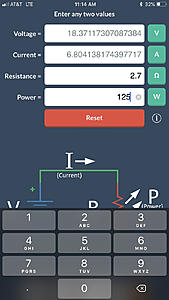Gain Setting Question
#1
Voltage = square root of Watts x Ohms
My B52 is rated at 200 Watts @ 4 Ohms and 250 Watts @ 2 Ohms
Why do all the voltage calculation examples for odd impedance speakers, 2.7 for example, always show the 2 Ohm Watts X 2 Ohm, why not 4 Ohm Watts X 4 Ohms? Neither one is accurate. If 2 Ohms is 250 Watts and 4 Ohms is 200 Watts, then 2.7 is somewhere in the middle, so I assume that one calculation would be too high, the other too low?? In this example wouldn’t you calculate the voltage both ways and split the difference?
Jim
My B52 is rated at 200 Watts @ 4 Ohms and 250 Watts @ 2 Ohms
Why do all the voltage calculation examples for odd impedance speakers, 2.7 for example, always show the 2 Ohm Watts X 2 Ohm, why not 4 Ohm Watts X 4 Ohms? Neither one is accurate. If 2 Ohms is 250 Watts and 4 Ohms is 200 Watts, then 2.7 is somewhere in the middle, so I assume that one calculation would be too high, the other too low?? In this example wouldn’t you calculate the voltage both ways and split the difference?
Jim
#2
Join Date: Aug 2014
Location: Lockport Illinois
Posts: 2,620
Likes: 0
Received 463 Likes
on
389 Posts
Voltage = square root of Watts x Ohms
My B52 is rated at 200 Watts @ 4 Ohms and 250 Watts @ 2 Ohms
Why do all the voltage calculation examples for odd impedance speakers, 2.7 for example, always show the 2 Ohm Watts X 2 Ohm, why not 4 Ohm Watts X 4 Ohms? Neither one is accurate. If 2 Ohms is 250 Watts and 4 Ohms is 200 Watts, then 2.7 is somewhere in the middle, so I assume that one calculation would be too high, the other too low?? In this example wouldn’t you calculate the voltage both ways and split the difference?
Jim
My B52 is rated at 200 Watts @ 4 Ohms and 250 Watts @ 2 Ohms
Why do all the voltage calculation examples for odd impedance speakers, 2.7 for example, always show the 2 Ohm Watts X 2 Ohm, why not 4 Ohm Watts X 4 Ohms? Neither one is accurate. If 2 Ohms is 250 Watts and 4 Ohms is 200 Watts, then 2.7 is somewhere in the middle, so I assume that one calculation would be too high, the other too low?? In this example wouldn’t you calculate the voltage both ways and split the difference?
Jim
https://www.rapidtables.com/calc/ele...alculator.html
#3
#4
#5
Originally Posted by USAproud
you want to set to what the speaker can handle not what the max output of the amp is. If the speaker is only rated 100w rms then 200 or 250 would be way to high. Plus, it's only a starting point and shouldnt be your final setting
#6
Why would you set your amp to max output without knowing what your speakers can handle. Use the chart in that sticky it’s very helpful. Figure out what you want to send to your speakers on left hand side. What ohm they will be receiving on top and follow down that’s what younger your gain output to. Then after that tune by ear.
#7
Trending Topics
#8
#9
So lets say you want to know what your voltage setting should be to obtain 100 watts to the speaker with a volt meter the your looking at Voltage = Square root of 100 Watts * 2.7 Ohms which would be Voltage = 10 * 2.7Ohms so Voltage to your speakers would need to be 27 Volts as a starting point
I personally depending on the speaker would start a % of Full RMS watts and then as everyone has said finish tuning by ear when you hear distortion back up a bit on your gains


